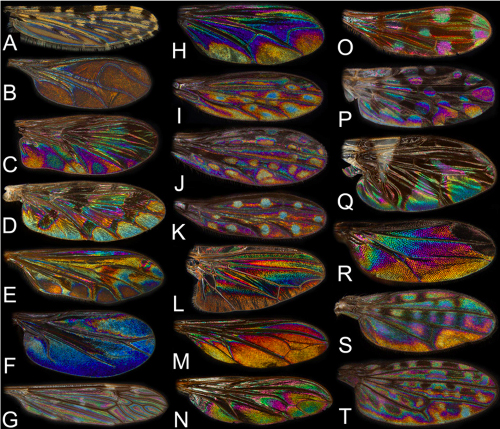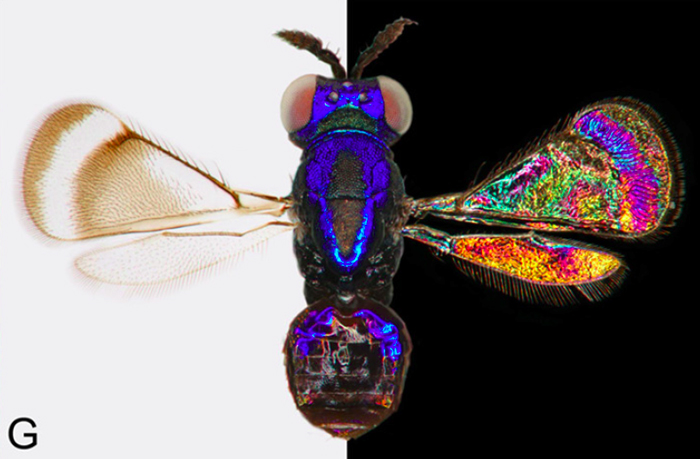Back in August, while at the International Congress of Dipterology in Costa Rica, I reported on a new species identification technique using some pretty sophisticated technology (i.e. a black piece of paper). The study was published today in PNAS (open access), so I thought I’d revisit it in more detail as our cool science of the week!
Although most people who have observed insects in the wild have likely seen flashes of colour as wings flick, it’s been assumed that those colours are random, much like those on the oily slicks in parking lots or around blown bubbles. Combined with the habit of most entomologists to use a white stage while examining their organisms, and you have the perfect storm for fortuitous discovery! After examining numerous Eulophidae wasps, the authors realized these colourful patterns were actually species specific (and in some species sexually dimorphic) and even lead to the discovery of a “cryptic species” complex. The authors then branched out and examined whether these Wing Interference Patterns (WIPs) could be found in other clear winged insects, and lo and behold, the same trends were found in Diptera!

Shevtsova et al., 2011, Diptera WIP Samples from 16 different fly families (left column = Nematocera, centre column = Lower Brachycera, right column = Acalyptratae)
The colours are a result of light being scattered by different thicknesses of chitin, and thanks to some fancy physics and computer algorithms, the thickness of the wing can be accurately measured just based on the observed colour. The potential for species recognition (both by eye and possibly through automated programs), functional morphology & evolution (the colours reveal atrophied wing veins), behavioural ecology (do insects use these patterns for intra- and interspecific communication in the dark jungle?), and developmental biology (the authors tie wing vein and pattern development back to early gene activity) are almost limitless! I expect that plenty of entomologists will be trying this inexpensive technique out over the coming months. I’m going to give it a try with my micropezids, and I’ll provide a sneak peek in the next week or two!
The paper is well worth a read (no worries, it’s only 6 pages), and every paragraph seems to hold another neat factoid concerning these beautiful patterns!
Bonus Quote on “Cryptic Species”:
“cryptic species” (which often means “not readily distinguishable by a large diurnal mammal with a microscope”)
Sweetly blunt.
Reference:
Ekaterina Shevtsova, Christer Hansson, Daniel H. Janzen, and Jostein Kjærandsen. Stable structural color patterns displayed on transparent insect wings PNAS published ahead of print January 3, 2011, doi:10.1073/pnas.1017393108 http://www.pnas.org/content/early/2010/12/27/1017393108.abstract
H/T to Miles Zhang for passing along the article.

I am totally trying this out on my eurytomids:)
That is really, really, really cool. I doubt it occurs widely in beetles since the membranous hindwings are covered by already-patterned elytra, but it would be neat to find out!
My guess is that there will be patterning, if for no other reason than because the wings are the same material and similar thickness. Whether they have been constrained by evolution is another question! Considering that most beetles still use their membranous hind wings for flight, they may in fact be useful for signaling. As always, a simple find creates more potential questions than answers!
Ok this is awesome….I want to make these photos artwork in my house!! Look out bees in the lab…you’re next 😉 I’m talking about you Hylaeus!!
Love the quote!
GORGEOUS photo, and that is soooooooo incredibly cool Morg!!! Cant wait to see if that works for my bees, and if not, my pan-trapped flies are next!